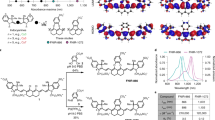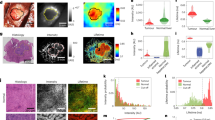Abstract
Fluorescent proteins have the properties of being very bright with high quantum yield and are available in many colors. Tumor-host models consist of transgenic mice expressing green fluorescent protein (GFP) in essentially all cells and tissues or expressing GFP selectively in specific tissues such as blood vessels. Particularly useful are the corresponding nude mice transgenic for GFP expression, as they can accept human tumors. When tumor cells expressing red fluorescent protein are implanted in mice expressing GFP, various types of tumor-host interactions can be observed, including those involving host blood vessels, lymphocytes, tumor-associated fibroblasts, macrophages, dendritic cells and others. The 'color-coded' tumor-host models enable imaging and therefore a deeper understanding of the host cells involved and their function in tumor progression. Approximately 4–8 weeks are needed for these procedures.
This is a preview of subscription content, access via your institution
Access options
Subscribe to this journal
Receive 12 print issues and online access
$259.00 per year
only $21.58 per issue
Buy this article
- Purchase on Springer Link
- Instant access to full article PDF
Prices may be subject to local taxes which are calculated during checkout







Similar content being viewed by others
References
Hoffman, R.M. The multiple uses of fluorescent proteins to visualize cancer in vivo. Nat. Rev. Cancer 5, 796–806 (2005).
Yang, M. et al. Dual-color fluorescence imaging distinguishes tumor cells from induced host angiogenic vessels and stromal cells. Proc. Natl. Acad. Sci. USA 100, 14259–14262 (2003).
Yang, M. et al. Transgenic nude mouse with ubiquitous green fluorescent protein expression as a host for human tumors. Cancer Res. 64, 8651–8656 (2004).
Amoh, Y. et al. Hair follicle-derived blood vessels vascularize tumors in skin and are inhibited by doxorubicin. Cancer Res. 65, 2337–2343 (2005).
Amoh, Y. et al. Nestin-linked green fluorescent protein transgenic nude mouse for imaging human tumor angiogenesis. Cancer Res. 65, 5352–5357 (2005).
Okabe, M., Ikawa, M., Kominami, K., Nakanishi, T. & Nishimune, Y. 'Green mice' as a source of ubiquitous green cells. FEBS Lett. 407, 313–319 (1997).
Amoh, Y. et al. Nascent blood vessels in the skin arise from nestin-expressing hair follicle cells. Proc. Natl. Acad. Sci. USA 101, 13291–13295 (2004).
Hoffman, R.M. Orthotopic metastatic mouse models for anticancer drug discovery and evaluation: a bridge to the clinic. Invest. New Drugs 17, 343–359 (1999).
Hoffman, R.M. In vivo imaging with fluorescent proteins: The new cell biology. Acta Histochem. 106, 77–87 (2004).
Author information
Authors and Affiliations
Corresponding author
Ethics declarations
Competing interests
R.M.H. is the president of AntiCancer, which has commercial activities in the area of fluorescent protein–based imaging and has a Technology Development with Olympus.
Rights and permissions
About this article
Cite this article
Hoffman, R., Yang, M. Color-coded fluorescence imaging of tumor-host interactions. Nat Protoc 1, 928–935 (2006). https://doi.org/10.1038/nprot.2006.119
Published:
Issue Date:
DOI: https://doi.org/10.1038/nprot.2006.119
This article is cited by
-
Intravital imaging to study cancer progression and metastasis
Nature Reviews Cancer (2023)
-
3′UTR polymorphisms of carbonic anhydrase IX determine the miR-34a targeting efficiency and prognosis of hepatocellular carcinoma
Scientific Reports (2017)
-
Sensitive and non-invasive method for the in vivo analysis of membrane permeability in small animals
Laboratory Investigation (2017)
-
Heterogeneity of macrophage infiltration and therapeutic response in lung carcinoma revealed by 3D organ imaging
Nature Communications (2017)
-
Comparison of in vitro invasiveness of high- and low-metastatic triple-negative human breast cancer visualized by color-coded imaging
In Vitro Cellular & Developmental Biology - Animal (2017)
Comments
By submitting a comment you agree to abide by our Terms and Community Guidelines. If you find something abusive or that does not comply with our terms or guidelines please flag it as inappropriate.



